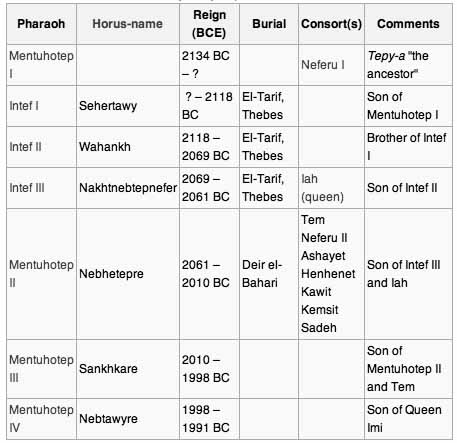
The Eleventh Dynasty of ancient Egypt (notated Dynasty XI) was one group of rulers, whose earlier members are grouped with the four preceding dynasties to form the First Intermediate Period, while the later members are considered part of the Middle Kingdom. They all ruled from Thebes. The known rulers are as follows:

Manetho's statement that Dynasty XI consisted of 16 kings, who reigned for 43 years is contradicted by contemporary inscriptions and the evidence of the Turin King List, whose combined testimony establishes that this kingdom consisted of seven kings who ruled for a total of 143 years. However, his testimony that this dynasty was based at Thebes is verified by the contemporary evidence. It was during this dynasty that all of ancient Egypt was united under the Middle Kingdom.
This dynasty traces its origins to a nomarch of Thebes, "Intef the Great, son of Iku", who is mentioned in a number of contemporary inscriptions. However, his immediate successor Mentuhotep I is considered the first king of this dynasty.
An inscription carved during the reign of Wahankh Intef II shows that he was the first of this dynasty to claim to rule over the whole of Egypt, a claim which brought the Thebeans into conflict with the rulers of Herakleopolis Magna, Dynasty X. Intef undertook several campaigns northwards, and captured the important nome of Abydos.
Warfare continued intermittently between the Thebean and Heracleapolitan dynasts until the fourteenth regnal year of Nebhetepra Mentuhotep II, when the Herakleopolitans were defeated, and this dynasty could begin to consolidate their rule. The rulers of Dynasty XI reasserted Egypt's influence over her neighbors in Africa and the Near East. Mentuhotep II sent renewed expeditions to Phoenicia to obtain cedar. Sankhkara Mentuhotep III sent an expedition from Coptos south to the land of Punt.
The reign of its last king, and thus the end of this dynasty, is something of a mystery. Contemporary records refer to "seven empty years" following the death of Mentuhotep III, which correspond to the reign of Nebtawyra Mentuhotep IV. Modern scholars identify his vizier Amenemhat with Amenemhat I, the first king of Dynasty XII, as part of a theory that Amenemhat became king as part of a palace coup. The only certain details of Mentuhotep's reign was that two remarkable omens were witnessed at the quarry of Wadi Hammamat by the vizier Amenemhat.
Mentuhotep I was the first pharaoh of Eleventh dynasty. He is also known as Montuhotep and his name honors the god Menthu. He was at first a local Egyptian prince at Thebes during the First Intermediate Period. He became the first openly acknowledged ruler of the Eleventh dynasty by assuming the title of first "supreme chief of Upper Egypt" and, later, declaring himself king over all Egypt. He is named as a nomarch in Thutmose III's royal list of the 'Hall of Ancestors' monument at Karnak.
Mentuhotep's wife was Neferu I. He was the father of Intef I, his successor, and Intef II. He was also a grandfather of Intef III. Mentuhotep I was a local Egyptian ruler at Thebes during the First Intermediate Period. He founded the Eleventh dynasty which eventually reunited Egypt under the Middle Kingdom. He is associated with Mentuhotep II. It is commonly thought that the two rulers were one and the same.
Intef I was a local Egyptian ruler at Thebes, and a member of the Eleventh dynasty during the First Intermediate Period. He was the first of his dynasty to assume the title of Pharaoh, with the Horus name of Sehertawy, ('He who has brought calm to the Two Lands'). Intef was the son of Mentuhotep I and Neferu I.
His authority was contested by the other nomarchs of Egypt, chief among them being the Tenth dynasty at Herakleopolis Magna and Ankhtifi, the well known nomarch of Hierakonpolis who was a faithful follower of the Heraklepolitan dynasty. On his accession to the throne, Intef probably ruled little more than the surrounding areas of his capital but he had gained control over Koptos, Dendera and the three nomes of Hierakonpolis by the end of his reign after apparently winning a victory over Ankhtifi or this nomarch's successor. His reign length is unknown but must have been less than 16 years since the damaged Turin Canon papyrus assigns this figure to the combined reigns of both Mentuhotep and Intef I. He was succeeded by his brother, Intef II.
He was buried in a long, narrow rock-tomb on the West-bank of Thebes.
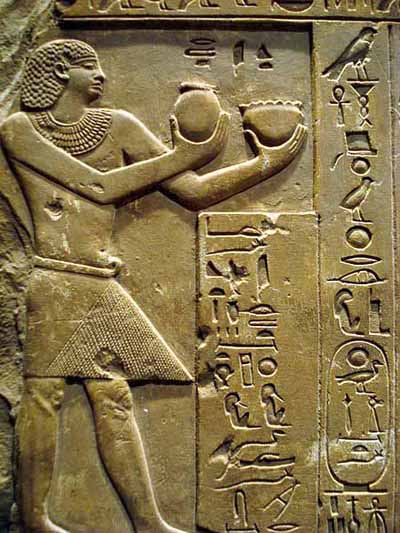
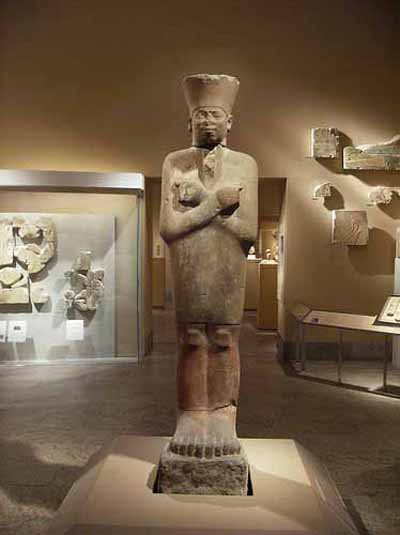
Intef II was a Pharaoh of the Eleventh dynasty during the First Intermediate Period. His capital was located at Thebes. At this time, Egypt was split between several local dynasties. After the death of the nomarch Ankhtifi, Intef was able to unite all the southern nomes down to the First Cataract. After this he clashed with his main rivals, the nomarchs of Herakleopolis Magna for the possession of Abydos. The city changed hands several times, but Intef II was eventually victorious, extending his rule north to the thirteenth nome.
After these wars, more friendly relations were established and the rest of Intef's reign was peaceful. The discovery of a statue of Intef II, wrapped in a sed festival robe, in the sanctuary of Heqaib at Elephantine suggests that this king's authority extended to the region of the First Cataract and, perhaps, over part of Lower Nubia by his 30th year. This impression would appear to be confirmed by an expedition led by Djemi from Gebelein to the land of Wawat (i.e.: Nubia) during his reign. Consequently when Intef II died, he left behind a strong government in Thebes which controlled the whole of Upper Egypt and maintained a border just south of Asyut.
The earliest attested dating of the god Amun at Karnak occurs during his reign. The surviving sections of the Turin Canon for the Middle Kingdom with Intef II; it assigns this king a reign of 49 years.

Intef III was the third pharaoh of the Eleventh Dynasty of Egypt during the late First Intermediate Period in the 21st century BC, at a time when Egypt was divided in two kingdoms. The son of his predecessor Intef II and father of his successor Mentuhotep II, Intef III reigned for 8 years over Upper Egypt and extended his domain North against the 10th Dynasty state, perhaps as far north as the 17th nome. He undertook some building activity on Elephantine. Intef III is buried in a large saff tomb at El-Tarif known as Saff el-Barqa.
Intef III's father and predecessor reigned for 49 years and Intef III may thus have accessed the throne a middle-aged or even elderly man. Although Intef III's name is lost in a lacuna of the Turin canon, a king list compiled in the early Ramesside period, its reign length is still readable on column 5, row 15, and given as 8 years.
The relative chronological position of Intef III as the successor of Intef II and predecessor of Mentuhotep II is secured by his established parentage to these two kings as well as the Turin canon and two blocks from the temple of Montu at Tod. These blocks show the succession of kings from Intef I to Mentuhotep II and while Intef III's horus name is damaged, its position is certain. The absolute dating of Intef III's reign is less certain and several dates have been proposed: 2069-2061 BC, 2063-2055 BC and 2016-2009 BC.
Intef III inherited a large and relatively peaceful domain in Upper Egypt. Over its 8 years of reign, Intef was militarily active. He successfully defended the territory that his father Intef II had won, as is attested by the tomb of an official of the time, Nakhty, located at Abydos and in which a doorjamb bearing Intef III's names was discovered. He also conquered territories north of Abydos, in particular Asyut and extended his domain perhaps as far as the seventeenth nome of Upper Egypt thereby "imposing his family's control over most of Upper Egypt". Alternatively, this may have been achieved by his son Mentuhotep II, early in his reign.
A doorjamb bearing Intef III's name was uncovered on Elephantine in the sanctuary of Hekayeb, a deified nomarch of the 6th Dynasty, which shows that he must have ordered work there. Another doorjamb was discovered in the temple of Satet, also on Elephantine which attests to building activity on the site.
The necropolis of the kings of the 11th Dynasty is located in El-Tarif, on the opposite bank of the Nile from Thebes. Several saff-tombs of imposing dimensions are found there but until the excavations of the German Archaeological Institute under the direction of Dieter Arnold from 1970 until 1974; it was unclear to whom some of these tombs belonged.
Although no inscriptions could be found in the tombs (except that of Intef II) to confirm their ownership, their positions, together with the much later-attested chronological succession of the rulers of the 11th Dynasty, led to the attribution of the tomb known today as Saff el-Baqar[8] to Intef III. The tomb resembles that of his predecessor Intef II and consists of a 75 m (246 ft) wide and 85-90 m (279-295 ft) long courtyard on a northwest - southeast axis facing a canal. The courtyard is surrounded, on all sides but the east, by many chambers dug into the rock. The courtyard leads to a large double-pillared facade totalling 48 columns behind which many more chambers are located.
The Middle Kingdom is a period in the history of ancient Egypt stretching from the establishment of the Eleventh Dynasty to the end of the Fourteenth Dynasty, roughly between 1991 BC and 1648 BC.
The Middle Kingdom has been usually dated to the time when Pharaoh Mentuhotep II from Thebes defeated the last king of the Tenth Dynasty around the 14th Year of his reign to reunite Egypt thus bringing an end to the First Intermediate Period. Some authorities point to cultural differences between the Eleventh and Twelfth Dynasties, and date the Middle Kingdom to the beginning of that dynasty.
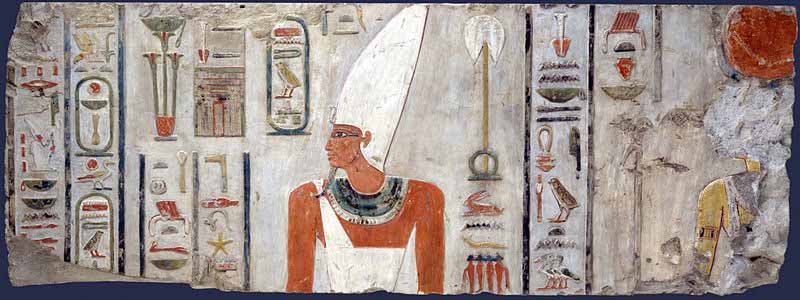
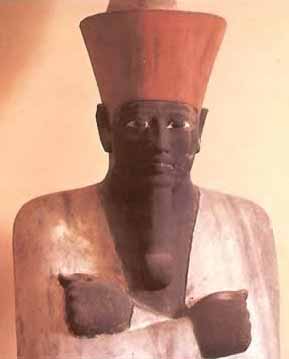
(2046 BC - 1995 BC)
His throne name was Neb-hetep-re, meaning "Pleased is the Lord Re".
He was the son of Intef III and queen Iah. His own wife was the 'king's mother' Tem. Other consorts were Neferu II (his sister) and several secondary wives, one or more who it has been suggested were possibly Nubian, buried in his funerary complex. His only known son was Mentuhotep III.
Many Egyptologists have long considered two rock reliefs, showing Mentuhotep II towering over smaller figures labeled king "Intef", to be conclusive evidence that his predecessor Intef III was his own father; this is, however, not entirely certain, as these reliefs may have had other propagandistic purposes, and there are other difficulties surrounding Mentuhotep's true origin, and his frequent attempts to claim descent from various gods.
The king seems to have changed his "Horus name" at least twice during his reign - in his 14th year, marking the beginning of his campaign against Herakleopolis Magna to the north; and again in about his 39th, marking the final success of that campaign, and his reunification of all Egypt. His throne name was Nebhepetre, and he was the first ruler of the Middle Kingdom of Egypt. The Turin Canon credits him with a reign of 51 years.
In the 14th year of his reign, an uprising occurred. This was probably connected with the conflict between Mentuhotep II based in Thebes and the rival 10th dynasty based at Herakleopolis.
During his reign, Mentuhotep was able to reunite ancient Egypt for the first time since the 6th dynasty. The exact date when reunification was achieved is not known, but it is assumed to have happened shortly before year 39 of his reign.
Mentuhotep II also led military campaigns south into Nubia (in his 29th and 31st years), which had gained its independence during the First Intermediate Period. There is also evidence of military actions against Canaan. The king reorganized the country and placed a vizier at the head of the administration. The viziers of his reign were Bebi and Dagi. His treasurer was Khety who was involved in organising the sed festival for the king. Other important officials were the treasurer Meketre and the overseer of sealers Meru. His general was Intef
Mentuhotep II was buried in a large tomb he had constructed at Deir el-Bahri. Mentuhotep II built temples and chapels at several places in Upper Egypt. These places include Denderah, Abydos, Armant and Gebelein.
Mentuhotep II was considered by his subjects to be divine, or half divine.
Mentuhotep II was the son of the Theban ruler Antef III and a woman named Iah. When he came to power, his predecessors had already conquered a territory that stretched far beyond Thebes, from the 1st cataract in the south, to the region of Qaw el-Kabir in the north.
The Turin King-lists credits this king with a reign of as much as 51 years. In light of the many events that occurred during his reign, this is not unlikely.
Mentuhotep II was responsible for the reunification of Egypt.
His achievements can be reviewed by looking at how his Horus name changed during his rule. He started off calling himself "He who gives heart to the Two Lands", and then moved on to "Lord of the White Crown" (the White Crown being symbolic of Upper Egypt). Finally, he became known as "Uniter of the Two Lands".
The first years of his reign have left us with only few testimonies. This could mean that he reached the throne at a young age, something that is also suggested by the long duration of his reign. His 14th regnal year was apparently a turning-point in the life of Mentuhotep. Its name "year of the crime of Thinis" suggests that there was some trouble in the Thinite province, where the age-old holy city of Abydos was located. Apparently the Heracleopolitan king Kheti of the 9/10th Dynasty had succeeded in re-conquering this province and was threatening to do the same with the rest of Upper-Egypt. During this re-conquest, a large part of the old necropolis of Abydos was destroyed.
Mentuhotep immediately reacted and not only repelled the Heracleopolitans from Abydos, he also continued the war against them, conquering Assiut, Middle-Egypt and finally Heracleopolis itself. With the fall of the Heracleopolitan Dynasty, nothing stood in the way for the final re-unification of Egypt under Theban rule.
At the latest by his 39th year, but presumably somewhere around his 30th year, Egypt was united again and Mentuhotep II was the first Theban who could rightfully call himself King of Upper- and Lower-Egypt thus ushering in the Middle Kingdom.
Mentuhotep's military efforts were not only aimed at reuniting the Two Lands. Inscriptions in Nubia show his desire to re-establish the Egyptian supremacy over this region. A mass-tomb found in Deir el-Bahari contained 60 bodies of slain Egyptian soldiers who perhaps lost their lives in Nubia. That these soldiers were given a burial so near the king's own funerary monument, demonstrates how much importance was attached to them.
Even during the re-conquest of Egypt, Mentuhotep built or restored several temples throughout his territory. He was particularly active in Upper-Egypt as is shown by monuments in Dendara, Abydos, Elkab and Elephantine. The warrior-king paid special homage to the war-god Montu, who, at that time, was the principal god of the Theban province. For him he built temples in Medamud, Armant and Tod.
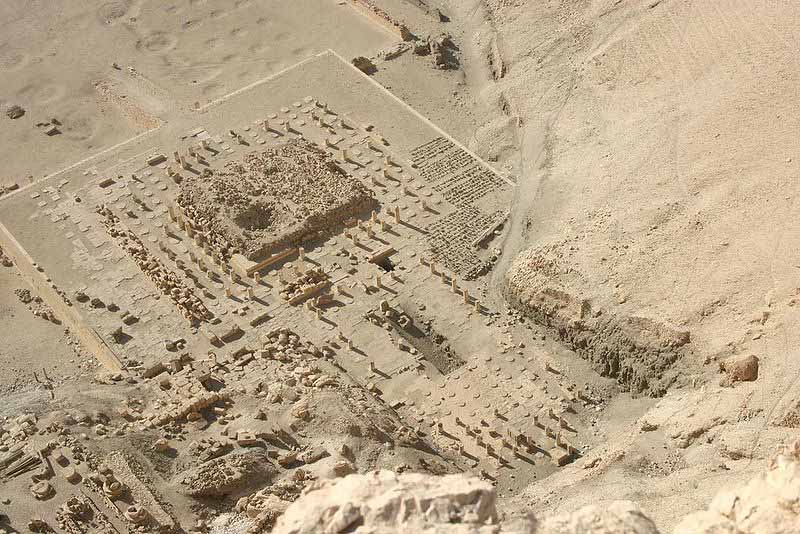
A view on the remains of Mentuhotep's funerary temple (foreground). The larger building in the background is Hatshepsut's temple, the design of which was largely based on Mentuhotep's.
The most famous monument built by Mentuhotep II was his funerary monument. Unlike his predecessors, who were buried in relatively simple tombs in Dra Abu el-Naga', Mentuhotep chose to build his mortuary temple and tomb at Deir el-Bahari. The design of this building was unique: a terrace was built against the cliffs of Deir el-Bahari. Upon the roof of that terrace was built a massive stone construction, identified by some archaeologists as a pyramid, by others as a mastaba. The tomb of the king was located in the rock behind and underneath the temple.
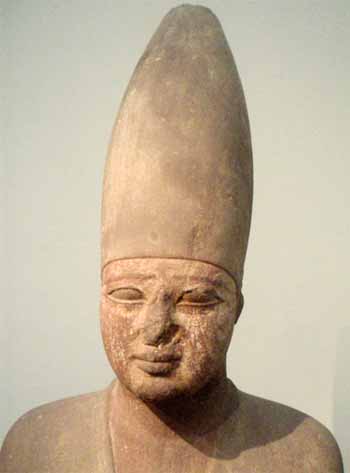
Sankhkare Mentuhotep III (Mentohotep III)[3] of the Eleventh dynasty was Pharaoh of Egypt during the Middle Kingdom. He was assigned a reign of 12 years in the Turin King List.
Mentuhotep III was the son and successor of Mentuhotep II. One of the wives of Mentuhotep II, Tem, was given the title Mother of the Dual King and based on that title she is almost certainly the mother of Mentuhotep III. Pharaoh Mentuhotep III's family is a mystery and it is not known if his successor Mentuhotep IV was a son of his or not.Mentuhotep IV's mother is known to have been Queen Imi. If he was the son of Mentuhotep III, Imi must have been the wife of Mentuhotep III.
Sankhkare Mentuhotep had a mud-brick temple erected at Thoth Hill in Western Thebes. The temple was built on the site of an older archaic temple. It was dedicated to the god Horus. This temple may have been destroyed by an earthquake towards the end of the 11th dynasty.
Sankhkare Mentuhotep was responsible for several building projects in the 12 years of his reign. His own mortuary temple was begun in Deir el-Bahari, but never completed. The temple was located a short distance from his father's mortuary temple. A causeway would have led up to a temple platform. Inscriptions show that the king was buried in a chamber cut into the rock-face.
Mentuhotep IV was the last king of the 11th Dynasty. He was the son of a woman named Imi, who was a secondary wife of either Mentuhotep II or Mentuhotep III.
This Mentuhotep is missing in most king-lists. The Turin King List merely notes 7 missing years at the end of this dynasty, just after the reign of Mentuhotep III. This probably refers to a gap in the documentation of about 7 years, which may have been filled by Nebtawire's reign. An offering table found in Karnak mentions the "Father of the God" Sesostris, the father of Amenemhat I, the founder of the next dynasty, in his place.
Either Mentuhotep IV was considered as an usurper, or the kings of the 12th Dynasty decided to re-write history to justify their claims to the throne. That he was not recognized as the legitimate king of the country may perhaps be supported by the many opponents to his reign: Antef, who may have been a member of the royal family, Iy-ib-khent-re and Segerseni all assumed royal titulary, thereby stating that they had more rights to the throne.
During the second year of his reign, he organized an expedition to the quarries of the Wadi Hammamat, located to the north-east of Thebes, between Koptos and the Red Sea. The 19 inscriptions left behind there by the members of the expedition are the only testimony to this Mentuhotep's reign.
The expedition was led by a vizier named Amenemhat, who is assumed by most Egyptologists to have been the later king Amenemhat I. A stone plate found at Lisht, bearing both the names of Mentuhotep IV and of king Amenemhat I may perhaps indicate that Amenemhat I was a co-regent during the later years of Mentuhotep's reign. This in turn could perhaps indicate that Mentuhotep IV had intended Amenemhat to be his successor.